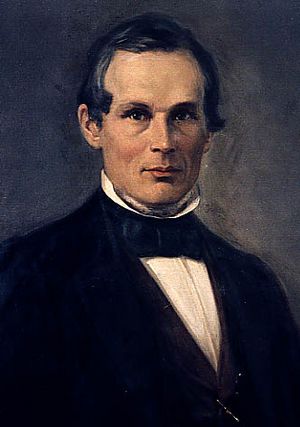Angstrom facts for kids
An angstrom (pronounced ONG-strum) is a super tiny unit of length. It's so small that you can't see it! The angstrom is often written with the symbol Å.
Imagine a meter stick. Now, imagine dividing that meter into ten billion equal parts. One of those tiny parts is an angstrom! So, an angstrom is 0.0000000001 meters, or 1/10,000,000,000 of a meter.
This unit is used to measure things that are incredibly small. For example, scientists use angstroms to describe:
- The size of atoms.
- The length of chemical bonds between atoms.
- The wavelength of light, especially visible light.
- The tiny parts inside integrated circuits, like those in your computer or phone.
Contents
What is an Angstrom?
The angstrom is a special unit of length. It is not part of the official International System of Units (SI), which includes meters and kilograms. However, it is still recognized and used by scientists around the world.
To give you an idea of how small it is:
- One angstrom is equal to 0.1 nanometers.
- A nanometer is one billionth of a meter.
- So, an angstrom is even smaller than a nanometer!
Scientists often use scientific notation to write such small numbers. An angstrom can be written as 1×10−10 meters. This is a short way of saying 0.0000000001 meters.
History of the Angstrom Unit
The angstrom unit is named after a brilliant Swedish physicist named Anders Jonas Ångström (1814–1874). He was one of the first scientists to study spectroscopy. This is the study of how light interacts with matter.
Ångström's Work with Light
In 1868, Ångström created a detailed chart of solar radiation. This chart showed the different wavelengths of light coming from the Sun. He measured these wavelengths in multiples of one ten-millionth of a millimetre. This is the same as one ten-billionth of a metre. This tiny unit of length later became known as the angstrom (Å).
Why the Angstrom Was Useful
The angstrom became very popular in science for a few reasons:
- Measuring Light: Human eyes can see light from about 4,000 angstroms (violet light) to 7,000 angstroms (deep red light). Using angstroms made it easy to describe these different colors of light without using confusing fractions.
- Atomic Scale: The size of atoms and molecules is very close to the angstrom scale. This made it a perfect unit for scientists studying chemistry and crystallography. Crystallography is the study of how atoms are arranged in solid materials.
Modern Use of the Angstrom
Today, the angstrom is not used as much as it used to be. The nanometer (nm) has become more common. Many scientific organizations, like the International Committee for Weights and Measures, now suggest using nanometers instead of angstroms.
Even though the nanometer is now preferred, the angstrom is still an important part of scientific history. It reminds us of the amazing work done by scientists like Anders Jonas Ångström.
See also
 In Spanish: Ángstrom para niños
In Spanish: Ángstrom para niños


